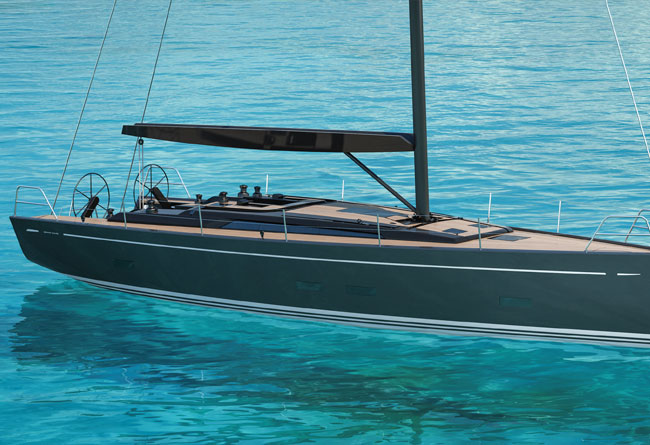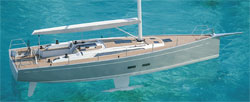

Over the years the builders of Grand Soleil yachts have repeatedly been forced to enlarge their trophy cabinet... and that performance heritage still flows through their current – and expanding – selection of racer-cruisers
Italian yard Cantiere del Pardo have been blending performance, luxury and contemporary style in their Grand Soleil range for 45 years. With the new Grand Soleil 48 the yard aims to raise the racer-cruiser bar to a whole new level.
‘Made in Italy’. Those three words can conjure up images of immaculately tailored suits and exquisitely engineered cars, of Pavarotti and Michelangelo, Sangiovese and bruschetta, the seemingly effortless elegance that is la dolce vita. Except, of course, it’s very far from effortless. The fine Italian thread running through the fabric of this nation is passion. Since its establishment in 1973, Cantiere del Pardo, based a few kilometres inland of Rimini, has been harnessing this emotional obsession with perfection and in the new Grand Soleil 48 it finds its latest, and perhaps most complete, expression.
She was drawn by the yard’s own design maestro Marco Lostuzzi, the third boat he has designed for Grand Soleil, and he worked closely with Milan-based Nauta Design on the styling. ‘The brief was to design a racer/cruiser that could be prepared for a racing customer or for a cruising one,’ says Lostuzzi, whose design philosophy is deceptively simple.
‘I design boats that are enjoyable and easy to sail. To achieve this I focus on the balance between sail area, displacement and stability. The mix has to be powerful, but not extreme. My first consideration was displacement. For a racing boat it has to be medium or light. At the same time, on a performance cruiser the weight is increased by the long list of optional extras that today’s customer wants onboard. It was difficult to determine the ideal displacement – and consequently the right volume and shape of the hull – to balance performance and comfort. Ultimately I went for a medium-light displacement and then employed various design strategies to deliver a boat that can be both raced and cruised.’ One of those strategies resulted in the Grand Soleil 48 becoming the only production yacht to offer a choice of two cockpit layouts, but more on that later.
‘We worked with Fluid4Engineering, a specialist CFD consultant here in Italy, to optimise the hull and appendages,’ adds Lostuzzi. ‘They were able to analyse many different hull and appendage options and combinations in various heel, trim and speed conditions, and the resulting forces and moments of each one.
‘As well as CFD, we used FEA analysis tools to improve the structural rigidity and to save weight in all the composite parts of the boat. The key stage in the design process was comparing the results of the CFD analysis and the VPP to find the best hull shape for our target wind range. This was fundamental to achieving the all-round performance we wanted.
‘The hull we chose has narrow entry lines at the bow, with round underwater sections and vertical hull sides. Moving aft the rocker becomes progressively flatter with flared hull sides at the stern. The freeboard and beam are generous, especially at the stern, to provide the volume needed for the cruising aspect of the brief. We went for a single rudder, placed quite well forward so that it’s always fully immersed, because the waterline beam of the aft sections is not wide enough to need twin rudders.’
The two-channel brief must have thrown up a lot of decisions during the design process. Did Lostuzzi and his team make many changes? ‘No, mostly refinements,’ he replies. ‘For instance, the volume was a bit too full in the stern so we moved the centre of volume forward a bit compared with the original design. Another refinement emerged when, together with Nauta Design, we built a full-scale mock-up of the interior at Cantiere del Pardo. After exploring the space we decided to increase the freeboard aft by 3cm to get more room above the two aft cabin berths. This meant we could put the headboards aft, which makes the berths easier to use. We were careful to check how this affected the lines of the hull, but it didn’t change the aesthetics.’

Above: Substantial bulb for mechanical stability but, without silly draft to make shallow water access a challenge, plenty of fin area to ensure a yacht with a wide groove for the helmsman and a ‘not unpleasant’ interior (below) in which to wind down after collecting your prizes. Of course you could just go cruising…

How is this multi-purpose hull powered? ‘The standard sailplan is a 9/10 fractional rig with a big mainsail, a 108 per cent jib for upwind work and a gennaker flown from a bowsprit offwind. Ease of handling was key. The high-aspect jib tacks, gybes and furls easily, the big mainsail is powerful but it’s easily depowered with the traveller. The gennaker, in a sock or on a furler, is much easier to use than a symmetric spinnaker. It’s a sailplan that works really well on a medium-light displacement boat like this, one that generates good apparent wind speeds.’
Different sailplans are on offer too. The Performance version has a pinhead main with a single backstay, and the Race version a square-top main with running backstays and a longer bowsprit, which will increase downwind performance particularly. ‘Our analysis showed that the performance gain outweighs the rating penalty,’ says Lostuzzi.
The Grand Soleil 48 also has two rig options: aluminium as standard, with a carbon option. Both have rod rigging. ‘For the Race version we opted for a carbon mast with a hydraulic ram to tension the forestay, and that set-up is very demanding in terms of structural rigidity,’ he says. ‘In the most loaded area of the boat we have a main bulkhead made of composite fibres and a strong grid of longitudinal and transversal frames linking the keel matrix with the chainplates and the mast step. We use unidirectional carbon in these areas to improve rigidity.’
So how difficult was it to achieve that very fine balance between performance and comfort? ‘That’s a combination of many elements. For example, the beam creates space in the aft cabins and in the cockpit, but it also gives form stability, which we need to achieve a good righting moment.’
Lostuzzi highlights how the yard approached the project with clinical discipline. ‘The engineering challenge is twofold: use better materials, and use materials better. For example, to meet the required displacement for the Race version the interiors needed to be made with a lighter plywood, so we ran analyses on which thicknesses to use in the various parts of the joinery. For the composite parts we decided to use a lot more unidirectional carbon. We also scrutinised the lamination plans to save weight where possible without decreasing rigidity.’
The man charged with implementing the engineering is build manager Vincenzo Candela, and he was under no illusion as to the scale of the task. ‘This project has ambitious aims. We made decisions about materials and build because the boat had to be lightweight to produce race-winning performance, but it also had to have outstanding structural integrity, build quality and comfort for family cruising, because it’s a Grand Soleil.
‘We opted for multi-axial E-glass with epoxy vinylester resin to optimise structural rigidity and help keep the weight down. It’s laid up in a female mould for the best possible hull finish, and the core is 100kg/m3 foam with PVC foam used in the slamming area forward. We use a single vacuum bag to infuse the whole hull, which gives us complete control of the curing.
‘To support rig and keel loads the hull is reinforced with a composite frame of unidirectional carbon fibre and E-glass, and the four main composite bulkheads are also laminated into place using carbon fibre. This gives the hull exceptional structural stiffness while managing the weight to protect the all-important performance. All the joinery is finished with Alpi veneers, except in the heads where the laminate structure has a gelcoat finish for ease of cleaning and to protect against humidity.’
With over 80 per cent of their craftsmen having been with the yard for 20 years or more, Cantiere del Pardo have a huge amount of experience on which to draw. The complex build was handled almost entirely in-house with minimal outsourcing. ‘Keels are being fabricated by the SAT Foundry here in Italy, one of Europe’s leading foundries,’ adds Candela. ‘The fin is spheroidal graphite cast iron, which has much greater resistance to impact and fatigue, and the bulb is cast in lead. The steering system, supplied by Jefa, has stainless steel cables to give the best possible feel at the wheels, to reduce friction and simplify the system for optimum reliability and safety. To save weight the sheaves are aluminium.’
Making this boat genuinely dual purpose was, says Candela, ‘the most difficult part of the project. We analysed the market and identified two distinct types of Grand Soleil owner, one who, above all, loves to win races, and another who loves performance cruising with the family and may race for fun. To give the GS48 maximum appeal for both types of owner, we designed two cockpit layouts: Race and Performance.
‘Our professional racing consultants worked with Harken to optimise cockpit ergonomics using modelling software,’ he continues. ‘For the Race version they specified two Harken 50.2 Performa winches in the pit to handle halyards, two 60.2 Performa primaries in the cockpit and two 50.2 Performa mainsheet winches just ahead of the twin wheels. On the Performance version all the lines are ducted aft through the coamings to two banks of two Harken 60.2 radial winches just forward of the wheels. This leaves the forward cockpit entirely free of lines, creating a great place to relax, while the helm has all the sail controls within easy reach and can handle the boat alone.’
How happy is Lostuzzi with the Grand Soleil 48? ‘She definitely has the sleek modern elegance of a Grand Soleil yacht, but we’ve used sophisticated tools, skills and materials to deliver a boat with both high performance and comfort. It has the required blend of mediumlight displacement and powerful sail area, along with the generous righting moment necessary to balance the power of the sails. She’s a very elegant boat with dynamic, performance-inspired looks and a lot of interior space. So much passion went into her.’
Click here for more information on Grand Soleil »
We invite you to read on and find out for yourself why Seahorse is the most highly-rated source in the world for anyone who is serious about their racing.
To read on simply SIGN up NOW
Take advantage of our very best subscription offer or order a single copy of this issue of Seahorse.
Online at:
www.seahorse.co.uk/shop and use the code TECH20
Or for iPad simply download the Seahorse App at the iTunes store


